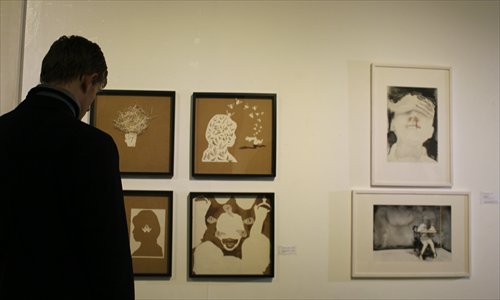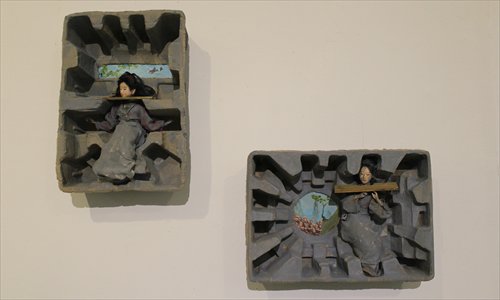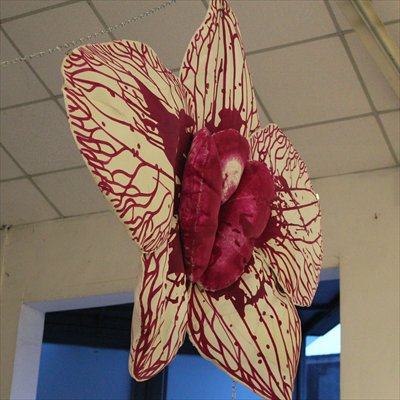HOME >> ARTS
For the women
By Xu Ming Source:Global Times Published: 2015-10-27 19:43:01
‘Intimate Transgressions’ touches on the pain of sexual violence

A man examines artwork at Intimate Transgressions at Inter Gallery in Beijing on October 25. Photo: Xu Ming/GT

Kamikaze Dream (left) and Hiroshige Idyll by Fion Gunn Photo: Xu Ming/GT

Formosa Orchid Series by Chen Mei-Tsen Photo: Xu Ming/GT
Bleeding navel cords, crimson bodies of plums riddled with injuries, entrapped girls in bloody lines. These images make walking through the Intimate Transgressions exhibition bound not to be a happy journey. Rather, it is painful and miserable, as was the artists' intention.Opened at the Inter Gallery in Beijing on Sunday, Intimate Transgressions boasts the works of 34 artists from all over the globe and focuses on violence, particularly sexual violence, against women from during World War II up to today.
"Seventy years on, organized war rape and genocide rape are now standard practice in many armed conflicts and women on every continent are affected. We wish to highlight this appalling abuse of human rights by presenting an exhibition," Fion Gunn and Niamh Cunningham, two curators for the exhibition, wrote in the introduction to the exhibition.
A global angle
Initiated by the New York-based Center for Asia Pacific Affairs, the exhibition first premiered at the Whitebox Art Center, in New York, last month. Beijing is the second stop on its world tour. Titled Intimate Transgressions, it features works by artists from China, Australia, India, Mexico, Ireland, the US, and so on, and shows a global perspective of the artists' understanding of the plight of "comfort women" during WWII.
These women, mainly from China, Korea, Philippines and other countries and regions occupied by the Japanese army, had suffered from inhuman sexual violence and brutality during the war. Among the tens of thousands of them, only a minority survived the war and even fewer are still alive.
"Following the end of hostilities their plight was sidelined, no one was held accountable for their suffering and their story was wiped from the Japanese history books by those in power," the exhibition's introduction said.
In the exhibition, their miserable past is not only recalled through photographic works but also through paintings and installations. All put together, they constitute a mournful wail that calls due attention to the still unsolved issue and at the same time warns against similar crimes against women today.
Fion Gunn, who is also an Irish artist, created two installations for the exhibition. In her works two Chinese dolls entrapped in cartons, their clothes covered in silt, are juxtaposed against idyllic Japanese-style fine paintings with a collaged group of Japanese soldiers marching, all smiling. "The refined aesthetic of the Japanese did not prevent their soldiers from gang raping women and little girls to death," Gunn wrote in the introduction.
"The Chinese dolls represent the victims. I used packaging materials because I was aware that when people are victims in this way they are treated like things and they are just objects," the artist shared with the Global Times.
Gao Yuan, a photographer from Taiwan who has been exploring the issue of comfort women, uses the face of a surviving Chinese "comfort woman," titled Say Sorry, I'll Forgive You to express her concern. "When I met those 14 surviving comfort women in Shanxi Province I felt really sad… It is so important that the whole world should know this forgotten history and understand its terrible legacy," Gao wrote in the introduction to her work, "I hope my artworks might encourage the Japanese Government to say sorry and to accept responsibility for what was done to these women."
A wider concern
While comfort women heavily influenced the title of the exhibition, it was not limited to war victims or the pain of victims of sexual violence. For example, Israeli artist Andi Arnovitz touches on the worry of mothers during war by lining a bloody navel cord between a mother and her son in the war.
There are also works that stress the plight for women in some regions beyond the war, emphasizing the universal nature of sexual violence in society. A typical example is Heide Hatry's work Violette Nozieres in which the artist uses pig skins, eyes, raw meat and a wig to create a sculpture of a woman as a platform to talk about child sexual abuse.
"The comfort women are part of a wider phenomenon. If you always look at just what happens to comfort women, in the West people think it is just an Asian problem. But it is a world problem. It continues, you know, … in the most terrible ways," Gunn told the Global Times.
According to Gunn, the project started about a year and a half ago. "It is a very interesting combination. For a number of years, I've been interested in the issue of conflict and the impact it has on women. In 2012, I did an exhibition with Gao Yuan about what happens to women at times of revolution. And she introduced other artists of the same interests."
Gunn said she was moved a lot by the elderly "comfort women" who came forward and spoke about their experiences. "It was such a brave thing to do. So we hope this exhibition will help those who are victims of sexual violence, not just women, children too, to come forward and say 'You know this happened to me. I have no reason to be shamed. The people who did this to me should be shamed.'"
Through the exhibition, Gunn said they want to send two messages. "First, we need to change the way the society views the victims of sexual violence. The society has to be very welcoming and receptive to them, so to make it easier for them to speak about their experiences and thereby recover," Gunn said.
She said it was also important to examine what causes men to be violent. "If our military systems are creating a hierarchy where men become broken people, we need to say to our military 'don't do this.' We need to think of the ways we raise our sons, to make sure they grow up to be normal people."
The exhibition closes on November 1 and will go on to Shanghai, Guangzhou and Taipei next year.
Posted in: Art